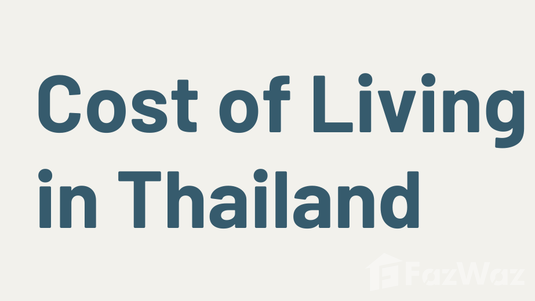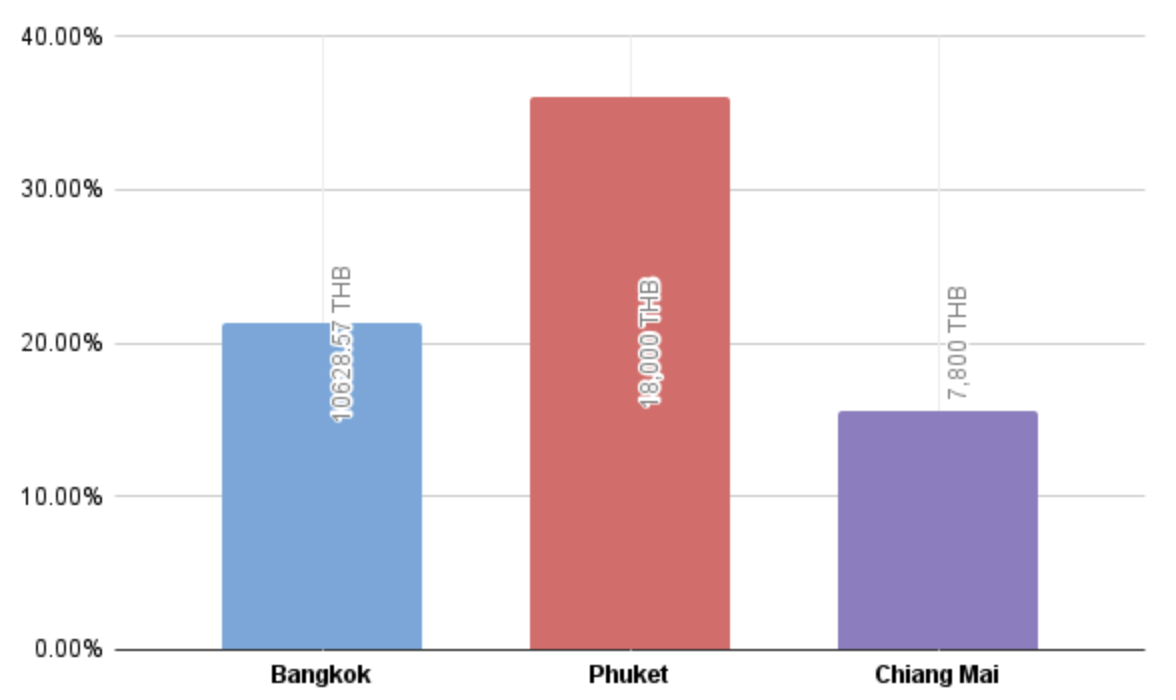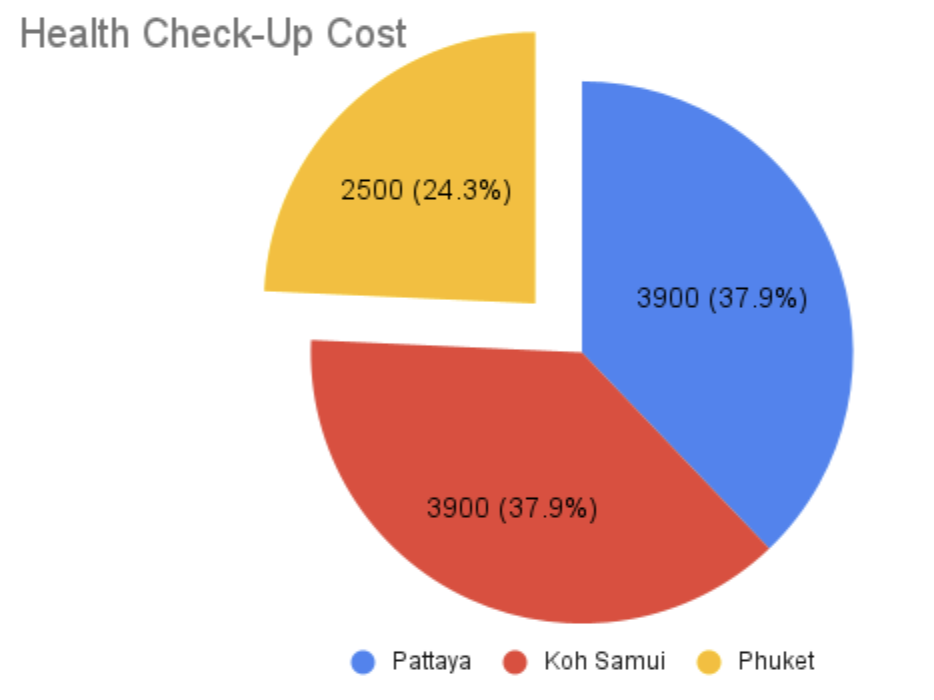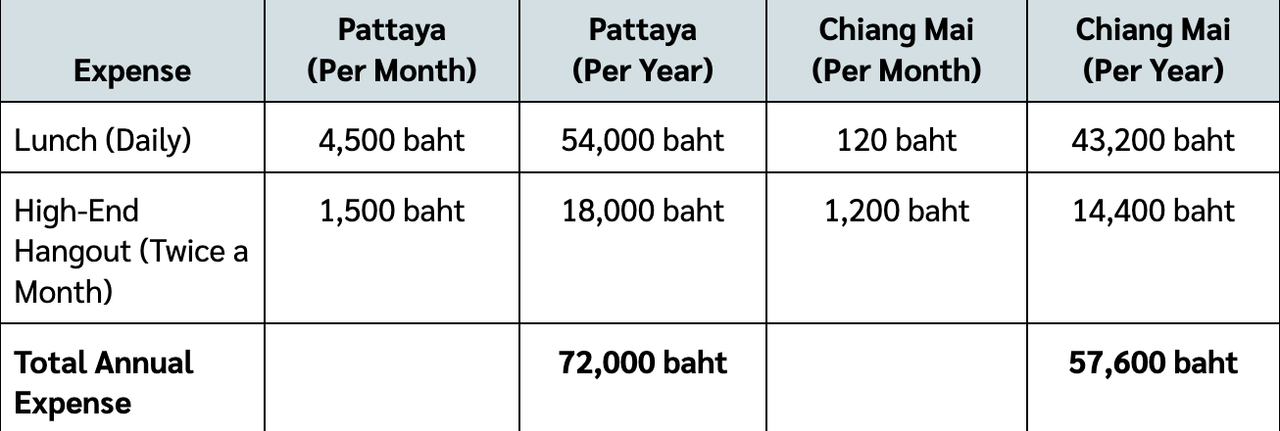- List your property - it's free
- Sign up or Log in
-
English- en
-
THB - ฿
- Buy
- Thailand Property For Sale
- Thailand Real Estate
- See Newest Listings
- Why Buy with FazWaz
- Rent
- Sell
- Projects
- Advice
- Property Management
- Vacation Rental Management

Consider Thailand as your next home. A country known for having a good standard of living, friendly people and beautiful homes. Additionally with a very fast internet connection. To truly live a Thai life, an understanding of the cost of living in Thailand is essential. This isn't just about money exchanging hands. It's about appreciating how your everyday life, from the food you eat to the activities you enjoy, and from the home you live in impacts your finances.
The cost of living in Thailand is a key tool that influences significant life decisions. This data acts as a road map, guiding you to make informed decisions about where to live in Thailand. It can be a beachfront villa in Phuket or a modern city view condo in Bangkok. By understanding your monthly and annual living cost, you can match your lifestyle choices with your budget, ensuring a satisfying and sustainable life in tropical paradise.
The cost of living is essentially the sum of all the expenses that an individual must meet to live comfortably in a specific location. These costs typically encompass necessities such as housing, food, and taxes, but can also extend to transportation, healthcare, entertainment, and even education. Cost of living is a calculation that measures the certain amount of income needed for a certain lifestyle. Everything from housing, to daily basic grocery needs. Cost of living can go down or up depending on each city or region's economy, goods and services they provide.
To get a full breakdown of cost of living in Thailand. Check out FazWaz Thailand cost of living calculator. Comparing 6 main regions in Thailand: Bangkok, Phuket, Chiang Mai, Hua Hin, Pattaya and Koh Samui.
We are going to provide example of your monthly cost of living with six main categories: housing, grocery, transporation, health, utilities cost and miscellaneous cost comparing six regions and locations in Thailand. We are going to start with housing cost in Thailand.
Understanding the percentage of personal income allocated to housing costs is crucial. The percentage varies based on individual circumstances. But as a general guideline, financial experts recommend allocating around 30% of your monthly income towards housing expenses. These costs encompass rent or mortgage payments, utilities, and other related expenses - for example, if you monthly earn 50,000 THB, then you should allocate about 15,000 THB for housing-related expenses.

In terms of specific cities, if you live in Bangkok and pay 10,628.57 THB per month for a 62 sq.m. condo, it would represent approximately 21.3% of a 50,000 THB monthly income. In Phuket, where the cost is 18,000 THB, it would account for around 36% of the same income. On the contrary, in Chiang Mai properties cost is 7,800 THB making up approximately 15.6%. For a full breakdown of Chiang Mai rental housing cost in 2023 and 2024.
To calculate the percentage of transportation expenses from the average income per person in Thailand, we need to consider the monthly transportation cost and compare it to the annual average income.
Based on current data, a significant portion of the population utilizes Bangkok BTS service, which offers a 50-trip prepaid monthly pass priced at 1,300 baht. Additionally, the extension stations add-on an approximate cost of 700 baht per month. Consequently, the total monthly transportation expenditure amounts to around 2,000 baht (24,000 baht per year). Kindly note that this calculation excludes additional travel expenses from accommodations to the BTS station, which can vary depending on the distance covered by each individual.
For more information on how BTS is the main drivers of condo prices in Bangkok. Check out the artice and guide from the link.
Here's a comparison table showing the transportation expenses as a percentage of the average income per person in Thailand and the United States:

When comparing the percentages, we can see that transportation expenses represent a higher proportion of the average income in Thailand (9.65%) compared to the United States (1.28%). This difference can be attributed to various factors, including income levels between the two countries.
GrabTaxi, also known as Grab, is a well-known ride-hailing service operating in various Southeast Asian countries, including Thailand. It provides a convenient transportation option for both residents and visitors to navigate the bustling cities of Bangkok and Phuket. The fare rates for Grab Taxi differ in Bangkok and Phuket, as illustrated in the table below.

The table above presents the monthly and annual fare calculations for using GrabTaxi for a daily commute in both Bangkok and Phuket. The fares have been calculated based on the given information regarding base fare and additional fare per kilometer.
In Bangkok, the GrabTaxi base fare is 45 baht as a base fare, with an additional charge of 8 baht per kilometer. For a monthly round trip distance of 400 kilometers (20 km per working day), the estimated monthly fare is 3,245 baht, and the annual fare is 38,940 baht (based on 4,800 kilometers for 234 working days in a year).
Thailand's Universal Coverage Scheme (UCS) provides healthcare coverage to approximately three-quarters of the population, which is about 47 million people. This accounts for 17% of the country’s healthcare expenditure and is primarily funded through taxes, ensuring that those who are more able to afford it bear a larger share of the costs. You'll find varying starting prices in different regions regarding health check-ups.

The starting prices in Pattaya and Koh Samui offer at 3,900 THB. In contrast, Phuket provides a more affordable option starting price of only 2,500 THB. It means that starting price in Phuket is 37.9% lower than those in Pattaya and Koh Samui. This information will help you prioritize your health by considering these prices and choosing the region that best suits your budget and lifestyle.
For a guide of how healthcare is booming in Bangkok and contributing to the real estate market in Bangkok is here.
In the lively coastal city of Pattaya, daily meals vary in cost. Mid-range restaurants charge approximately 150 to 200 baht per meal, whereas local eateries offer dishes for around 40 to 70 baht. Hanging out at more premium establishments could cost around 500 to 1,000 baht per visit.

Conversely, Chiang Mai, with its tranquil mountainous backdrop, offers cheaper dining options. Meals at mid-tier restaurants cost roughly 100 to 150 baht, while street food can be as low as 30 to 50 baht. Enjoying higher-end hangouts twice a month may cost between 400 to 800 baht each.
Prices fluctuate according to location, season, and personal choices. Pattaya's costs are slightly higher than Chiang Mai's. However, both cities present a diverse range of food options to cater to various budgets.
Cost of living Calculator: Compare Now
A cost of living comparison provides insights into the affordability of different locations based on your salary. By comparing expenses between cities or towns, you can gain clarity on your living journey and identify regions that offer both affordability and the desired standard of living. This allows you to target areas that align with your budget and lifestyle preferences. Government policies, supply and demand dynamics, and inflation rates also influence the cost of living. Taking these factors into account allows for better financial planning and decision-making.
Economy:
The state of the economy plays a crucial role in determining the cost of living in any country, including Thailand. Economic indicators like GDP growth, employment rates, and foreign investment levels directly impact individuals' purchasing power. During periods of economic growth, higher consumer spending may lead to increased demand and potentially higher prices. Conversely, economic downturns or recessions can result in reduced purchasing power and more cautious spending habits.
Supply and Demand:
Supply and demand dynamics significantly influence the prices of goods and services in any market, including Thailand. Factors such as population density, urbanization, and tourism contribute to the demand for various products and services. Regions with high population densities or popular tourist destinations often experience greater demand for housing, food, transportation, and entertainment, which can drive up prices.
Government Policies in Thailand:
Government policies in Thailand also play a significant role in shaping the cost of living. Policies related to trade, taxation, infrastructure development, education, healthcare, and tourism impact various aspects of daily life and can influence prices.
Inflation:
Inflation, the gradual increase in prices over time, directly affects individuals' purchasing power. In Thailand, inflation rates are influenced by factors such as government policies, currency stability, and global economic conditions. Higher inflation rates correspondingly raise the cost of living, as the prices of goods and services increase.
The Cost of Living Index in popular regions of Thailand provides insights into relative expenses. Bangkok reflects a higher cost of living, while Pattaya offers affordability. Hua Hin strikes a balance between cost and comfort, Phuket is known for higher expenses, and Chiang Mai and Samui often offer affordability. These variations help individuals choose a location aligning with your financial priorities and desired lifestyle.
In 2021, Bangkok boasted a Cost of Living Index of 55.4. Being the capital city, it is not surprising that it led the pack in terms of living expenses. Pattaya followed closely with an index of 52.0, while Phuket was not far behind at 51.0. Chiang Mai presented a more economical option with an index of 47.21.
Fast forward to 2022, we observe a slight decline in the cost of living Index across the board. Bangkok’s index dropped to 50.4, indicating a moderation in living expenses. Pattaya’s index was recorded at 44.3, while Phuket’s dipped to 39.4. Chiang Mai further solidified its position as an economical alternative with an index of 37.723.
As we venture into the year 2023, the trend of declining living costs continues unabated. Bangkok's index now stands at 49.8. Pattaya and Phuket registered indices of 39.4 and 42.0, respectively. Chiang Mai remains an attractive destination for those seeking lower living expenses, with an index of 37.73.